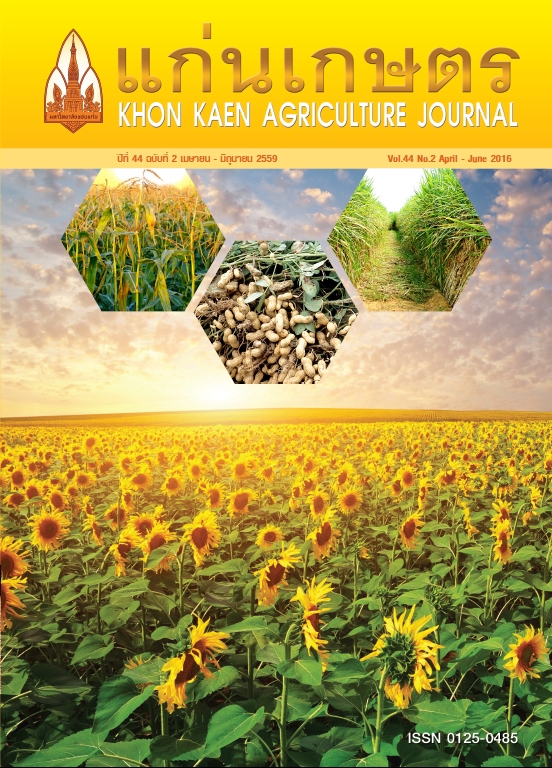Effect of waterlogging on morphological changes and growth of six forage grasses
Main Article Content
บทคัดย่อ
Waterlogging from successive rain depressions causes problems for forage grasses in the low lying areas of northeast Thailand. Six promising forage grass cultivars [Ubon paspalum (Paspalum atratum cv. Ubon), Mombasa guinea (Panicum maximum cv. Mombasa), Purple guinea (P. maximum cv. Purple), Mulato II (Brachiariaruziziensis x B. decumbens x B. brizantha cv. Mulato II), Cayman (B. ruziziensis x B. decumbens x B. brizantha cv. Cayman), and humidicola (B. humidicola)] were studied for waterlogging tolerance. The objectives were to evaluate these forage grasses on 1) the effect of waterlogging at late vegetative phase on morphological changes and growth; and 2) the effect of repeated waterlogging (with 30 days recovery period) at the late vegetative phase on morphological changes and growth. The results showed that: 1) Waterlogged grasses had yellow and dried out leaves and more adventitious roots; plant height, number of tillers, and leaf area were lower (P < 0.05); and total dry weight started to lower at 40 days of waterlogging compared to those of control (P < 0.05). Ubon paspalum tolerated best to waterlogging followed by humidicola, Cayman, Purple guinea, Mombasa guinea; while Mulato II was the most susceptible. 2) Repeated waterlogging with recovery period caused yellowish and dried out leaves, stimulated the production of adventitious roots, new leaves, and new shoots. Plant height was higher, but the number of tillers and leaf area were lower compared to those of control (P < 0.05). Waterlogging once with recovery period seemed to do no harm on grasses; but repeated waterlogging with recovery period as well reduced total dry weight (P < 0.05). Humidicola tolerated best to repeated waterlogging followed by Ubon paspalum, Cayman, Purple guinea, Mombasa guinea; while Mulato II was most susceptible.
Article Details
เอกสารอ้างอิง
Division of Livestock Extension and Development (DLED). 2012. Strategy for beef in 2012-2016. Available: http://www.dld.go.th/th/images/stories/news/Strategy/55-59%20strategy_beef.pdf. Accessed January, 2015. (in Thai).
Dobermann, A., and T.H. Fairhurst. 2000. Rice: Nutrient Disorders & Nutrient Management. Potash & Phosphate Institute, Potash & Phosphate Institute of Canada, and International Rice Research Institute.
Donald, H. 1984. Adaption to Flooding with Fresh Water. In Flooding and Plant Growth. Kozlowski, T.T. ed. Academic Press, New York.
Gomez, K., and A. Gomez. 1983. Statistical Procedures for Agricultural Research, 2nd edition. International Rice Research Institute, Los Banos.Hare, M.D., K. Thummasaeng, W. Suriyajantratong, K. Wongpichet, M. Saengkham, P. Tatsapong, C. Kaewkunya, and P. Booncharern. 1999. Pasture grass and legume evaluation on seasonally waterlogged and seasonally dry soils in Northeast Thailand. Tropical Grasslands. 33: 65-74.
Hare, M.D., C. Kaewkunya, P. Tatsapong, and M. Saengkham. 2003. Evaluation of forage legumes and grasses on seasonally waterlogged sites in north-east Thailand Tropical Grasslands,37: 20-32.
Hare, M.D., M. Saengkham, P. Tatsapong, K. Wongpichet, and S. Tudsri. 2004. Waterlogging tolerance of some tropical pasture grasses. Tropical Grasslands. 38: 227-233.
Hare, M.D., P. Tatsapong, and S. Phengphet. 2009. Herbage yield and quality of Brachiaria cultivars, Paspalum atratum and Panicum maximum in north-east Thailand. Tropical Grasslands, 43: 65 - 72.
Kozlowski, T.T., and S.G. Pallardy. 1984. Effect of Flooding on Water, Carbohydrate, and Mineral Relations. In: Flooding and Plant Growth. Kozlowski T.T. ed. Academic Press, New York.
Luana, P. de S.C., and M.B. Dias-Filho. 2008. Responses of six Brachiaria spp. accessions to root zone flooding. R. Bras. Zootec. 37: 795-801.
Nishiuchi, S., T. Yamauchi, H. Takahashi, L. Kotula, and M. Nakazono. 2012. Mechanisms for coping with submergence and waterlogging in rice. Rice. 5: 2. Available: http://www.thericejournal.com/content/5/1/2. Accessed Jul. 13, 2015.Office of Agricultural Economics (OAE). 2012. Situations and Trends of some Important Agricultural Produces in 2013. Available: http://www.dld.go.th/th/images/stories/news/Strategy/5559% 20strategy_beef.pdf. Accessed Jun., 2014. (in Thai).
Saengkum, M. 2000. Effects of Waterlogging, Method of Establishment and Severity and Frequency of Defoliation on Yield and Quality of Ubon paspalum (Paspalumatratum cv. Ubon). Master of Science (Agriculture)’s thesis. Kasetsart University, Bangkok. (in Thai).
Sampet, C. 1992. Crop Physiology. Odeon Store, Bangkok. (in Thai).Suwannasophon, P., and A. Jampeetong. 2012. Aerenchyma: tissue formation, patterns and its function. Thai Journal of Botany. 4: 125 - 138. (in Thai).
Taiz, L., and E. Zeiger. 1991. Plant Physiology. The Benjamin/Cummings Publishing Company, California.
Tanchai, P. 2005. Physiological Characteristics of Young Wax-Apple (Syzygium sp.) Plants under Flooding Conditions. Master of Science (Horticulture)’s thesis, Kasetsart University. (in Thai).
Tudsri, S. 2004. Tropical Pastures. Kasetsart University Press, Bangkok. (in Thai).
Weier, K.L. 1980. Nitrogen fixation associated with grasses. Tropical grasslands. 14: 194-201.
Whiteman, P.C. 1980.Tropical Pasture Science. Oxford University Press, Oxford.
Yoshida, S. 1981. Fundamentals of Rice Crop Science. International Rice Research Institute, Los Banos.


